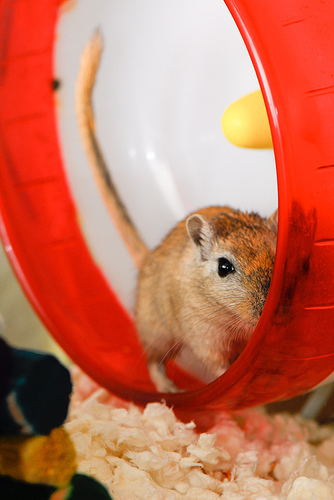Mongolian gerbils (Meriones unguiculatus) and fancy mice (Mus musculus) are two of the most common small communal animals people choose as pets – but there are quite big differences between them with regards to group dynamics, habits and homes.
This quick comparison guide should help you understand these differences and give you an insight into their care if you do chose them as pets in the future:
Mongolian Gerbils – Typical Lifespan: 2.5 years to 4 years
Fancy Mice – Typical Lifespan: 1.5 year to 2 years
Now let’s get down to the real details…
Shape & Size:
Gerbils stand tall and and quite slender – spending a lot of their time sitting on their strong back legs like mini kangaroos – their long fluffy tail helping them to balance – fancy mice are quite similar – but with an extra angle: they have grasping hands and feet as well as a tiny prehensile tail. This means they can do a lot of things that gerbils can’t and they need this to be taken into account for housing and safety.
Both can be carried around by young people very easily, however fancy mice, tend to be quite clingy and like to hide in creases, folds and hoods – and want to want to sit on your shoulders or head. Gerbils tend to be quite happy in your hands or up your arms.
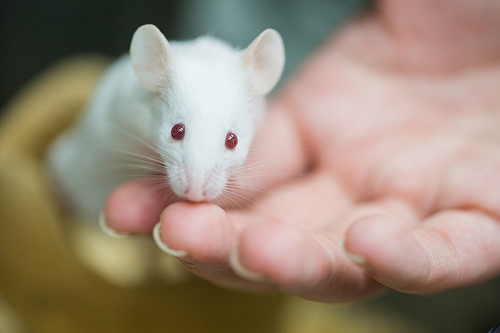

Fancy mice are tiny compared to gerbils – which tend to be between 60g – 100g on average. Fancy mice though can vary considerably in size depending on whether they are ‘show mice’ or ‘pet mice’ and the difference in size can be huge. Show mice are selectively raised for size (up to around 90g) but pet mice are just left to their own devices (and rarely top 30g).
Fancy mice have been selectively bred for so much longer than gerbils that they now come in a HUGE variety of colours (including lavender, mock chocolate and silver), coat types (including angora, frizzy and fuzzy) and a huge variety of different markings (including belted, broken merle and tri-colour). As a result it is sometimes difficult to tell them all apart.
Gerbils however have more simple colours (including black, argente and nutmeg) and only a few very standardised markings following a pattern of progressively more white parts rather than new patterns (including tri-spot (three small spots), collared (spots and a larger band around the shoulders) and mottled (collared but with more patches of white all over the rump).
Family & Friends:
Female fancy mice LOVE friends and can easily live together in groups or 10 or more – and the groups can change size quite easily without too much upset – with females in and out willy-nilly. As long as the set-up is big enough and has enough little hidey-holes – they will all get along fine.
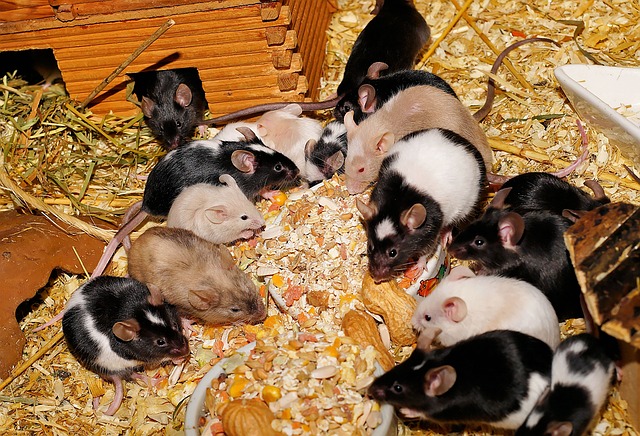
Not so much adult male fancy mice. They never live in groups – rarely live in related pairs – and most often end up alone. This is what they prefer – so who are we to argue.
Male gerbil on the other hand are very sociable and are happy to live in large groups – particularly if it is the dad and his sons. All gerbil clans can squabble of course at some point – but a pair of males or a father-led clan are some of the most stable.
Related female gerbils of the same age can live in pairs from pups without too much fuss and mother and daughter clan will most often do well too. You can also split tank together two females of any age and once together they should be just fine. However, females in groups of three or more, mothers with more than one daughter or two similar-aged but unrelated females are prone to declans (nasty fights with potentially some serious wounds).
No gerbils like strangers though (unlike female mice) – so never just put gerbils together on a whim – it needs to be planned over time (see Split Tank Introductions – What is a Split Tank?.)
Character & Cuddles:
Gerbils are very inquisitive at all times of day – they aren’t generally nocturnal, or creatures of habit, so putting anything new into their tank at any time will no doubt wake them up and start some activity.
Female fancy mice colonies are the same – but generally because there is always someone awake in their community rather than them being nosy. Male mice can be just as nosy if you get their attention though.
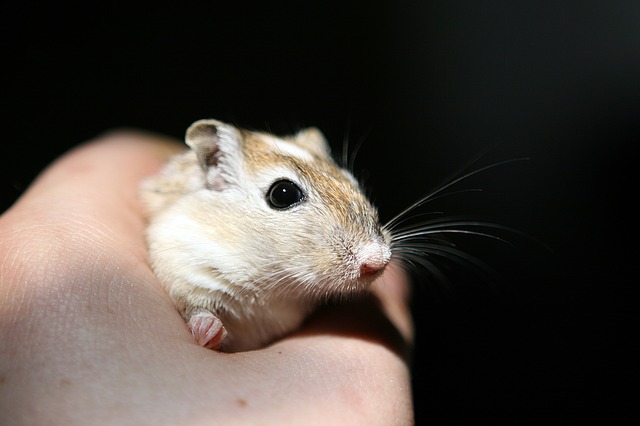
Fancy mice rarely bite are really happy to run all over you or in a play run – but not so much for cuddles. If left to their own devices they would explore every square inch of wherever they are – they are always seemingly ‘going somewhere’. Gerbils however, can really stop and interact with you – watching your next move (once they have sussed out the place).
Gerbils will also often come looking for attention at any time of day and you often find them peering out at you from inside their home. The more inquisitive ones can also appear to respond to their names. Male fancy mice may appear to react to your presence – but you won’t find female fancy mice doing this – they are too busy ‘going somewhere’…
Gerbils don’t generally bite either when your are handling them (like most members of the extended gerbil/jird family) – it is catching them that can be the problem – having to dig them out from under a foot of bedding can take some time! Best to train them to come to the top of the tank for a treat (which is easily done).
Home & Housing:
This is a place where gerbils and fancy mice differ – for health and safety reasons really.
Fancy mice – due to the minuscule size and ability to flatten themselves almost paper thin – can get out of virtually any cage with bars that are not specifically set up for fancy mice – which is basically 95% of all cages.
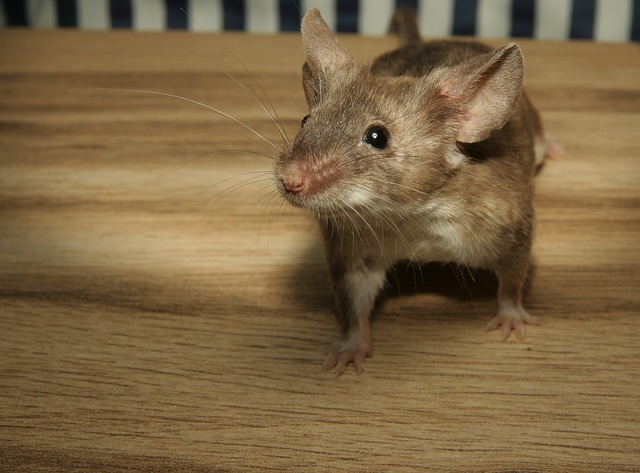
Cages with plastic bases and sides are more suitable – but all areas of bars, clips and catches need to be fancy-mouse small.
Gerbil tanks are very secure – so can mice live in glass tanks? Unfotunately no – fancy mice are prone to respiratory issues and the smell of their own waste (the ammonia) can build up in a glass tank with only one point of ventilation that these are not suitable. RUBs and Tubs with ventilation on the sides and top are more suitable and can be homemade easily.
Gerbils however, suit a tank perfectly. They don’t create such powerful-smelling waste and so can live in a tank with just one side ventilated – but are much better in a tank with a topper – adding all that fresh air to their enclosure.
They love to tunnel, dig and chew – and the deep bedding and cardboard needed to do that – something mice don’t really appreciate.
Fancy mice prefer a more acrobatic set up where they can climb up, across, through and over things – so a network or ropes, hammocks, suspended tubes and ledges are all great fancy mouse fodder. Gerbils however don’t really climb, suspend or dangle – and so appreciate none of these things.
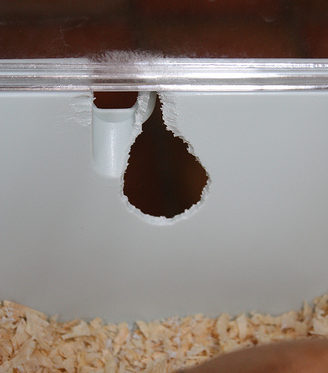
Safety-wise, just as fancy mice have the ability to get out of a small hole – gerbils have the ability to make a big one (see image).
Gerbils can chew though any weak point in a tank or other habitat within minutes – so plastic vents, plastic stoppers and plastic lids all all potential new doorways, and even solid wood enclosures will eventually be gnawed through to create a new front door.
Fancy mice, however, don’t really chew anything – unless they are making a nest – so they can have all sorts of interesting material and rope toys, beds and houses.
Smell & Scent-Marking
Fancy mice have got a particular odor – a general smell that lingers in your home even if you super-scrub their whole cage every day.
It isn’t unpleasant to those who love mice – but it will be noticeable to others. It is partly due to the make-up of their pee and poo which act as scent marks however, fancy mice do poo and pee a lot – and all over the place – so if you have any areas of bare metal or plastic – these will need spot cleaning.
Gerbils have a special gland in the middle of their tummies for scent-marking – so they don’t do it with liquids or solids like fancy mice do – therefore gerbils are one of the least ‘smelly’ pets for keeping indoors.
Gerbils have no overall odor in their coats either and glass doesn’t retain or enhance smells, so unless the bedding has been in the tank too long; the water bottle has leaked; or fresh food has spoiled, it won’t smell too bad.
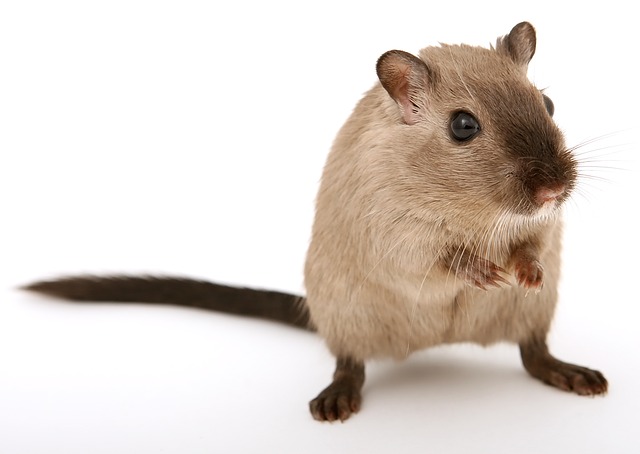
Due to their clean nature, gerbil tanks don’t need to be cleaned out fully on a weekly basis like fancy mice and they can go for several weeks or more before they need full cleaning. Using a sand bath or clear ledge helps – as they concentrate their pooping and peeing on that instead leaving the substrate cleaner for longer.
Foods & Feeding:
Both gerbils and fancy rats can eat roughly the same foods and have no special dietary requirements. They both do well on a commercially-made cereal-based food – either the muesli type (where you can see all the individual ingredients) or an extruded type (where all the ingredients are mashed together and you can’t see what the individual parts are).
Normal adult gerbils and fancy mice require about the same levels of protein, fats and fibre (12%, 6-8% and 4-6%) which are found in most store-brought products – as well as a sprinkling of fresh fruit and vegetables a few times a week from a species-relevant fresh food safe list.
They also both like a small amount of live food/dried live food including mealworms and waxworms etc – both eating such things in nature as part of their everyday lives as well as fresh plants and wood to chew on like young hazel (below).
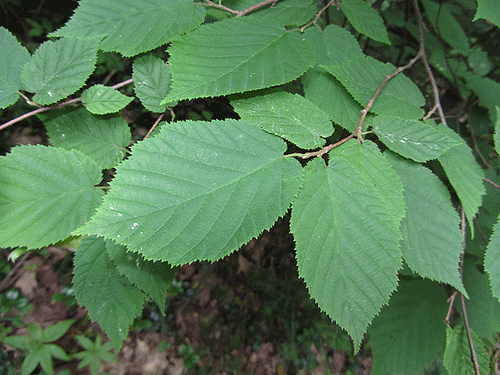

Healthy adult fancy mice and adult gerbils do not need vitamin or mineral supplements in their water or as mineral stones, but there is no harm in offering them at all – however, you might regret it when the fancy mice decide to use it as a pooing post!
Saying this though, sick, older, pregnant or lactating fancy mice and gerbils could well benefit from these and other extra nutrients.
Age & Illness:
Both gerbils and fancy mice are short-lived compared to other common rodents – but this doesn’t mean that they can’t have substantial lives.
Gerbils are deemed adult at around 12 weeks of age and can often live to 4 years or over – with 3 years being very common these days. Gerbil can die at any age of course, but this is usually due to accidents and internal genetics rather than potential lifespan.
However, many a gerbil life is cut short from several common illnesses which usually strike from 2 years onward – and these include: Scent Gland Tumours – found mainly in males; Ovarian Cysts – found only in females; Strokes and seizures which can affect any gerbils at any age.
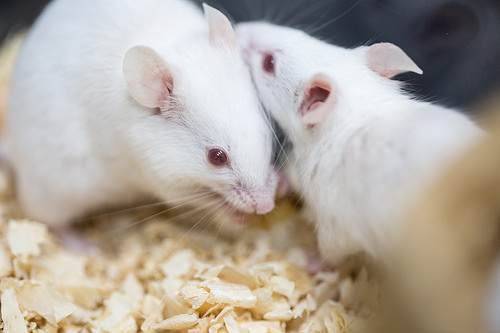

Fancy Mice are deemed fully grown at around 12-20 weeks of age – but can be fertile from as young as 4 weeks. They can often live to 2 years and can be much longer with wild-caught individuals.
Most common illnesses in fancy mice include but aren’t restricted to: Tumours – at any place and in any number; and Respiratory Infections – which can strike at any age. Veterinary treatments are available at suitable exotic vets for these – but these vets are very hard to find!
As male fancy mice live on their own – their illnesses don’t affect any others – but a sick gerbil (male or female) from a trio or more can have some obvious effects on a gerbil clan – generally making it unstable and sometimes causing any remaining gerbils to scuffle.
Also, it is quite normal in the gerbil (and mouse) world to start to eat your dead friend – so don’t be offended by your pets doing this – or assume that they killed their tank mate in the first place and then did this. They didn’t – they are just tidying up…
Breeding & Babies:
This is another area of pet keeping where gerbils and fancy mice differ considerably – and be very careful to get it the right way around for both pups and adults.
Gerbil parents live together for several months through the whole process – and can’t easily go back to live with who they were with before breeding – so don’t split up your favourite clans for mating as they probably won’t be best friend afterwards. Whereas female fancy mice share a few minutes or days with their partner, birth alone (ideally) and can go back with their community afterwards.
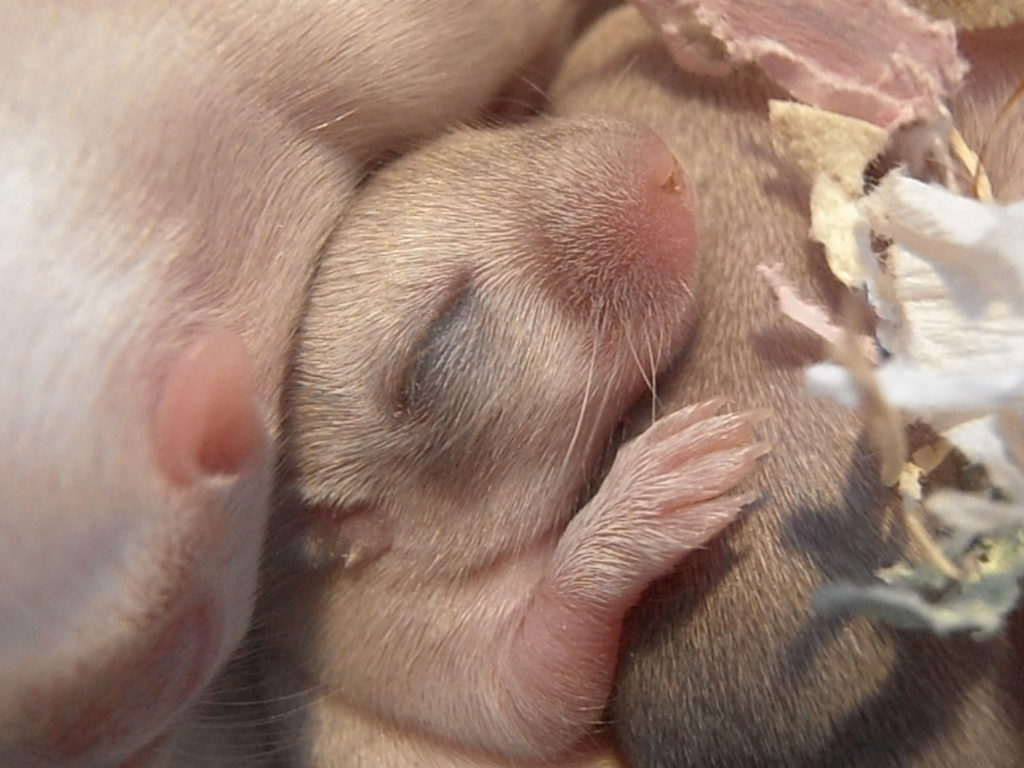
Time is short for breeding with fancy mice though as females can only really breed twice in a life time between the ages of 4 months and 1 year with a decent gap between litters (from weaning the first litter to conception). Female fancy mice come into heat every 4 to 5 days – but this can stop in an all female colony – only starting again several days after a male is introduced to stir up those hormones.
Breeding only one pair needs a separate cage of course – but if you have fertile females in a colony – you can put him in with them all and they should all become impregnated (not a successful strategy with gerbils). Females can live together in their colonies while pregnant (even if taken out for mating) but a few days before she is going to give birth – a single set up works best.
She stays separate from the colony until after weaning her litter for a month – which is also when the male pups need to be removed (at 4 weeks to prevent mating). Fancy mice males ideally need to not only be separated from their mother but from each other as often they will fight with other males – even siblings.
However with gerbils – things are a lot more relaxed. You simply split together a male and female gerbil and leave them to it for about 2-3 months.
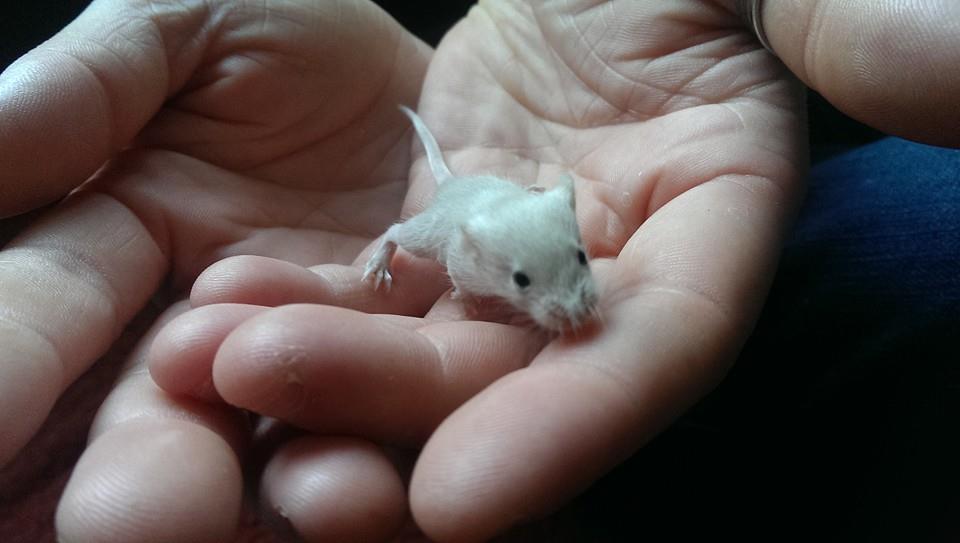
They will have their first litter together after about 3-4 weeks – and then about 3 weeks after that – you take out the male and all the male pups and all but 1-2 of the female pups. You leave the female and the daughter/s to raise the second litter together in the original tank.
All the male pups can stay with the dad in a giant clan if you want – or you can home some of the males pups in pairs while they are still under 12 weeks. The female pup/s you originally left with the mum can stay with the mum for their entire lives – although you will need to house all the ‘spare’ female pups in different tanks – in pairs where possible ready for homing (large clans of females over 4 months old can be quite unstable long-term).
Extras & Exceptions:
Gerbils usually have a sand bath to keep them clean – as it helps with the oils in their coats. Child-safe play sand is best – but you can also use the same dust/sand as for chinchillas or you can use corn flour for this. They will pee and poo in this as well as eat it? Fancy mice don’t really use this in the same way – and may prefer to wash or play in shallow water. (Gerbils don’t like water at all.)
Fancy mice don’t really enjoy a wheel – but around 50% of gerbils love them. A wheel for mice can be around 6″ diameter but gerbils do best with larger. Both need a solid thick plastic wheel rather than those with bars or moving sections which could trap tiny feet and tails.
However, a wheel in a tank isn’t more important than deep bedding for gerbils so don’t lower the level of bedding of the whole tank to fit it in – perhaps add a topper to fit in the wheel, or get a longer tank and divide it up into a shallow and a deep half instead?
